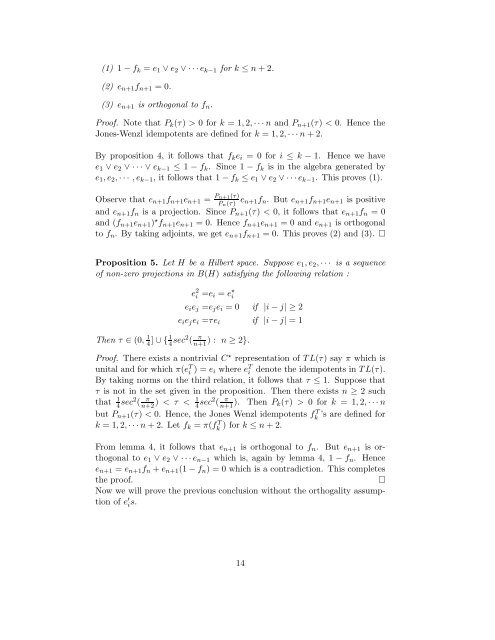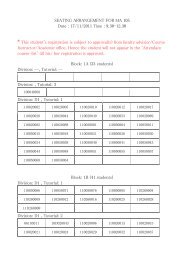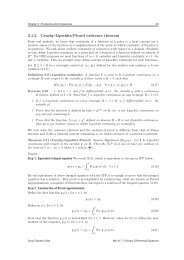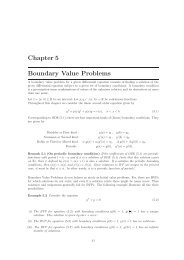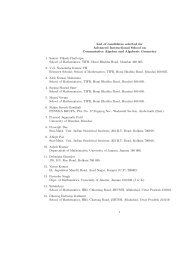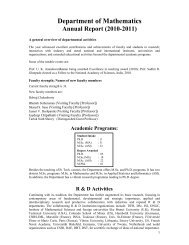the Masters' Thesis of S. Sundar
the Masters' Thesis of S. Sundar
the Masters' Thesis of S. Sundar
You also want an ePaper? Increase the reach of your titles
YUMPU automatically turns print PDFs into web optimized ePapers that Google loves.
(1) 1 − fk = e1 ∨ e2 ∨ · · · ek−1 for k ≤ n + 2.<br />
(2) en+1fn+1 = 0.<br />
(3) en+1 is orthogonal to fn.<br />
Pro<strong>of</strong>. Note that Pk(τ) > 0 for k = 1,2, · · · n and Pn+1(τ) < 0. Hence <strong>the</strong><br />
Jones-Wenzl idempotents are defined for k = 1,2, · · · n + 2.<br />
By proposition 4, it follows that fkei = 0 for i ≤ k − 1. Hence we have<br />
e1 ∨ e2 ∨ · · · ∨ ek−1 ≤ 1 − fk. Since 1 − fk is in <strong>the</strong> algebra generated by<br />
e1,e2, · · · ,ek−1, it follows that 1 − fk ≤ e1 ∨ e2 ∨ · · · ek−1. This proves (1).<br />
Observe that en+1fn+1en+1 = Pn+1(τ)<br />
Pn(τ) en+1fn. But en+1fn+1en+1 is positive<br />
and en+1fn is a projection. Since Pn+1(τ) < 0, it follows that en+1fn = 0<br />
and (fn+1en+1) ⋆ fn+1en+1 = 0. Hence fn+1en+1 = 0 and en+1 is orthogonal<br />
to fn. By taking adjoints, we get en+1fn+1 = 0. This proves (2) and (3). �<br />
Proposition 5. Let H be a Hilbert space. Suppose e1,e2, · · · is a sequence<br />
<strong>of</strong> non-zero projections in B(H) satisfying <strong>the</strong> following relation :<br />
e 2 i =ei = e ⋆ i<br />
eiej =ejei = 0 if |i − j| ≥ 2<br />
eiejei =τei<br />
Then τ ∈ (0, 1<br />
4 ] ∪ {1<br />
4sec2 ( π<br />
n+1 ) : n ≥ 2}.<br />
if |i − j| = 1<br />
Pro<strong>of</strong>. There exists a nontrivial C⋆ representation <strong>of</strong> TL(τ) say π which is<br />
unital and for which π(eT i ) = ei where eT i denote <strong>the</strong> idempotents in TL(τ).<br />
By taking norms on <strong>the</strong> third relation, it follows that τ ≤ 1. Suppose that<br />
τ is not in <strong>the</strong> set given in <strong>the</strong> proposition. Then <strong>the</strong>re exists n ≥ 2 such<br />
that 1<br />
4sec2 ( π<br />
1<br />
n+2 ) < τ < 4sec2 ( π<br />
n+1 ). Then Pk(τ) > 0 for k = 1,2, · · · n<br />
but Pn+1(τ) < 0. Hence, <strong>the</strong> Jones Wenzl idempotents fT k ’s are defined for<br />
k = 1,2, · · · n + 2. Let fk = π(f T k ) for k ≤ n + 2.<br />
From lemma 4, it follows that en+1 is orthogonal to fn. But en+1 is orthogonal<br />
to e1 ∨ e2 ∨ · · · en−1 which is, again by lemma 4, 1 − fn. Hence<br />
en+1 = en+1fn + en+1(1 − fn) = 0 which is a contradiction. This completes<br />
<strong>the</strong> pro<strong>of</strong>. �<br />
Now we will prove <strong>the</strong> previous conclusion without <strong>the</strong> orthogality assumption<br />
<strong>of</strong> e ′ i s.<br />
14


